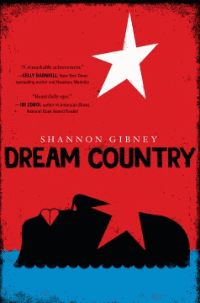Dream Country
 Dream Country
Dream Country
Historical Fiction / Liberia / U.S. Diaspora
Dutton
2018
368 pp.

"The ... story of five generations of young people from a single African-and-American family pursuing an elusive dream of freedom." Publisher
Author Shannon Gibney was inspired to write about the history of Liberia, with a focus on the interconnections between West Africans and African-Americans. Many important aspects of that history are included here. The disjointed chronology and gratuitous profanity, however, are concerning and limit the effectiveness of this novel.
This is a novel about the complicated history of Liberia and features the people who are part of that history, from the indigenous Africans to the formerly enslaved African-Americans who settled on the shores of West Africa. The action occurs from the 1820s in West Africa to 2018 in Minnesota, U.S.A., through the lives of one family. The book is structured in five parts, weaving back and forth across the Atlantic. The time frame begins in 2008 in Minnesota, shifting to 1926 Liberia, then to the southern U.S. in 1826, Liberia in 1980 and finally back to Minnesota in 2018. The author describes this as a spiraling, disrupted structure.
The story begins in Part I with Liberian teenager Kollie, living unhappily in exile with his family in Minnesota, after time in a Ghanaian refugee camp during the Liberian civil war of the 1990s and early 2000s. Part II takes the reader to Bassa County on the coast of Liberia in 1926. We follow the travails of young husband and father Togar, a Bassa man living under African-American settler rule, where African Liberians have few rights and can be conscripted into forced labor by Liberian government soldiers.
Part III is the longest section at 127 pages and follows the life of Yasmine and her children, who escape their life of slavery on a plantation in Virginia. They travel to Liberia in 1826 sponsored by the American Colonization Society. This section follows her dangerous escape, with help from people along the way, the journey to Liberia and her life of struggle in the new settlement on the coast of West Africa called Monrovia. They faced the challenges of a tropical climate, yellow fever and the resistance of local African communities. She loses two of her sons and when her daughter marries an African young man, Yasmine disowns her.
Part IV takes the reader to the lives of two young lovers, Evelyn and Ujay, in the Liberia of April, 1980. That month a coup by Liberian soldiers against the elite government of President William R. Tolbert resulted in riots, and the deaths of government officials and civilians. The end of this section takes place at a refugee camp in Ghana in 1998. Ujay is married to Kollie’s mother and awaiting the chance to emigrate to the United States.
Part V takes place in 2018 and is narrated by Kollie’s sister Angel, who tells the reader that she is the author of this story. She explains that the stories are a spiral, from continent to continent. Because the section on Togar in the 1920s, is followed by Yasmine in the 1820s, Part II has no context, and is, therefore, confusing to a reader unfamiliar with Liberian history. Angel writes that she did research, and “If one doesn’t have a coherent and unified country or family or story to call home, one may simply grab the facts she can and dream them up. What are facts if not the soil from which our dreams grow?” (327)
This is fiction, of course, but the confusing chronology distracted this reviewer. Also there are a number of inaccuracies (covered by grabbing facts and making a story?). The author uses the word “disbursing,” when the correct word is “dispersing” on p. 172. On p. 102, the author refers to savannah, when Liberia is located in the rain forest. On p. 289, a character refers to the “clans” of Kru, Grebo and Krahn. These are ethnic groups, speaking separate languages, not clans.
The list of suggested further reading does not include any Liberian historians. The timeline has important gaps: there is no acknowledgement that there were African communities on the shores of what became Liberia, only the Monrovia settlement is noted, and whole decades are ignored. A glossary would have been helpful for a non-Liberian reader: terms and locations could clarify elements of the story that are confusing. For example, Congoes or Congo man: In Liberia, this is a pejorative term for African-American settler elites, not as some might think, someone from the country previously known as Congo.
Also concerning is the gratuitous profanity. From the very first pages of this novel, entire sections are saturated with profanity and offensive language. Kollie and his friends use foul language in almost every sentence, whether in speaking to one another, or in Kollie’s thoughts about his classmates and his family. While most of that language is used in Part I among Kollie and his friends, in Part II, when Togar and his fellow villagers are attacked by Liberian soldiers, the soldiers are presented as cartoonish bad guys, who use disgusting and violent sexual language throughout their encounters (101-108). While the language that Yasmine uses to describe local Africans is typical of 19th century biases (lazy savages), the reader is not privy to the thoughts of Yasmine’s African neighbors.
This is a novel of the dreams of multiple generations, dreams of home, of freedom, and of justice. The story of Liberia deserves an engaging read for young people that presents her history fairly. The extensive profanity and foul sexual language are gratuitous and distract from the stories in this novel. I do not recommend this book.
Rating: Not recommended Grade: YA
Reviewed by Jo Sullivan, Ph.D. Independent Scholar
Published in Africa Access Review (February 18, 2019))
Copyright 2019 Africa Access
